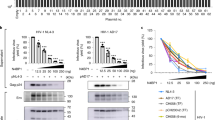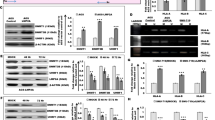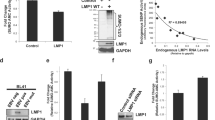Abstract
The latent membrane protein 1 (LMP1) of Epstein–Barr virus (EBV), a viral oncogene, is essential for transformation of resting B cells by the virus. We previously demonstrated that LMP1 could repress DNA repair in p53-wild-type and p53-deficient human epithelial cells. In this study, using a host cell reactivation (HCR) assay, we demonstrated that p53-enhanced DNA repair was repressed by LMP1 in p53-deficient cells. Moreover, we found that LMP1 was able to repress p53-dependent transcriptional activity. Regarding the mechanisms of p53 repression by LMP1, we found that LMP1 did not inhibit p53 function through direct interaction, by promoting protein degradation or reducing its DNA-binding ability. Using chimeric proteins in the reporter assay, we demonstrated that LMP1 inhibited p53 transactivation by influencing the N-terminal transactivation domain of p53. Subsequent experiments using various LMP1 deletion mutants indicated that a C-terminus-activating region of LMP1, CTAR1 or CTAR2, is responsible for the repression of p53-mediated DNA repair and p53-dependent transcription, which is correlated with the region responsible for NF-κB activation. Furthermore, blockage of NF-κB signalling by IκB-ΔN was shown to abolish the repression of p53 by LMP1, suggesting that LMP1 likely repressed p53 function through the NF-κB pathway. Based on these results, we propose that inhibition of p53-dependent transcriptional activity and DNA repair by LMP1 results in the loss of p53 activity for maintaining genomic stability, which may contribute to the oncogenesis of LMP1 in human epithelial cells.
This is a preview of subscription content, access via your institution
Access options
Subscribe to this journal
Receive 50 print issues and online access
$259.00 per year
only $5.18 per issue
Buy this article
- Purchase on Springer Link
- Instant access to full article PDF
Prices may be subject to local taxes which are calculated during checkout







Similar content being viewed by others
References
Adimoolam S and Ford JM . (2002). Proc. Natl. Acad. Sci. USA, 99, 12985–12990.
Adimoolam S and Ford JM . (2003). DNA Repair (Amst), 2, 947–954.
Akagi T, Ono H, Tsuchida N and Shimotohno K . (1997). FEBS Lett., 406, 263–266.
Albrechtsen N, Dornreiter I, Grosse F, Kim E, Wiesmuller L and Deppert W . (1999). Oncogene, 18, 7706–7717.
Atkinson PG, Coope HJ, Rowe M and Ley SC . (2003). J Biol. Chem., 278, 51134–51142.
Bertrand P, Saintigny Y and Lopez BS . (2004). Trends Genet., 20, 235–243.
Bohuslav J, Chen LF, Kwon H, Mu Y and Greene WC . (2004). J. Biol. Chem., 279, 26115–26125.
Burt EC, James LA, Greaves MJ, Birch JM, Boyle JM and Varley JM . (2000). Br. J. Cancer, 83, 467–472.
Cahir McFarland ED, Izumi KM and Mosialos G . (1999). Oncogene, 18, 6959–6964.
Capovilla A, Carmona S and Arbuthnot P . (1997). Biochem. Biophys. Res. Commun., 232, 255–260.
Chang NS . (2002). J. Biol. Chem., 277, 10323–10331.
Chien YC, Chen JY, Liu MY, Yang HI, Hsu MM, Chen CJ and Yang CS . (2001). N. Engl. J. Med., 345, 1877–1882.
Dawson CW, Rickinson AB and Young LS . (1990). Nature, 344, 777–780.
Eliopoulos AG, Caamano JH, Flavell J, Reynolds GM, Murray PG, Poyet JL and Young LS . (2003). Oncogene, 22, 7557–7569.
Eliopoulos AG and Young LS . (2001). Semin. Cancer Biol., 11, 435–444.
Florenes VA, Malandsmo GM, Forus A, Andreassen A, Myklebost O and Fodstad O . (1994). J. Natl. Cancer Inst., 86, 1297–1302.
Fujioka S, Schmidt C, Sclabas GM, Li Z, Pelicano H, Peng B, Yao A, Niu J, Zhang W, Evans DB, Abbruzzese JL, Huang P and Chiao PJ . (2004). J. Biol. Chem., 279, 27549–27559.
Groisman IJ, Koshy R, Henkler F, Groopman JD and Alaoui-Jamali MA . (1999). Carcinogenesis, 20, 479–483.
Harvey M, Sands AT, Weiss RS, Hegi ME, Wiseman RW, Pantazis P, Giovanella BC, Tainsky MA, Bradley A and Donehower LA . (1993). Oncogene, 8, 2457–2467.
He Z, Xin B, Yang X, Chan C and Cao L . (2000). Cancer Res., 60, 1845–1848.
Henderson S, Rowe M, Gregory C, Croom-Carter D, Wang F, Longnecker R, Kieff E and Rickinson A . (1991). Cell, 65, 1107–1115.
Hoeijmakers JH . (2001). Nature, 411, 366–374.
Honma M, Momose M, Tanabe H, Sakamoto H, Yu Y, Little JB, Sofuni T and Hayashi M . (2000). Mol. Carcinogen., 28, 203–214.
Huen DS, Henderson SA, Croom-Carter D and Rowe M . (1995). Oncogene, 10, 549–560.
Hwang BJ, Ford JM, Hanawalt PC and Chu G . (1999). Proc. Natl. Acad. Sci. USA, 96, 424–428.
Ikeda A, Sun X, Li Y, Zhang Y, Eckner R, Doi TS, Takahashi T, Obata Y, Yoshioka K and Yamamoto K . (2000). Biochem. Biophys. Res. Commun., 272, 375–379.
Janus F, Albrechtsen N, Dornreiter I, Wiesmuller L, Grosse F and Deppert W . (1999). Cell. Mol. Life Sci., 55, 12–27.
Jeang KT, Widen SG, Semmes OJt and Wilson SH . (1990). Science, 247, 1082–1084.
Jeong SJ, Radonovich M, Brady JN and Pise-Masison CA . (2004). Blood, 104, 1490–1497.
Kao SY, Lemoine FJ and Mariott SJ . (2000a). Oncogene, 19, 2240–2248.
Kao SY, Lemoine FJ and Marriott SJ . (2000b). J. Biol. Chem., 275, 35926–35931.
Kao SY and Marriott SJ . (1999). J. Virol., 73, 4299–4304.
Kaye KM, Izumi KM and Kieff E . (1993). Proc. Natl. Acad. Sci. USA, 90, 9150–9154.
Lee TH, Elledge SJ and Butel JS . (1995). J. Virol., 69, 1107–1114.
Levine AJ . (1997). Cell, 88, 323–331.
Li HP and Chang YS . (2003). J. Biomed. Sci., 10, 490–504.
Lin CS, Kuo HH, Chen JY, Yang CS and Wang WB . (2000). J. Mol. Biol., 303, 7–23.
Liu MT, Chen YR, Chen SC, Hu CY, Lin CS, Chang YT, Wang WB and Chen JY . (2004). Oncogene, 23, 2531–2539.
Majone F, Semmes OJ and Jeang KT . (1993). Virology, 193, 456–459.
Masuda H, Miller C, Koeffler HP, Battifora H and Cline MJ . (1987). Proc. Natl. Acad. Sci. USA, 84, 7716–7719.
Mitsudomi T, Steinberg SM, Nau MM, Carbone D, D'Amico D, Bodner S, Oie HK, Linnoila I, Mulshine JL, Minna JD and Grazdar AF . (1992). Oncogene, 7, 171–180.
Nowak MA, Komarova NL, Sengupta A, Jallepalli PV, Shih Ie M, Vogelstein B and Lengauer C . (2002). Proc. Natl. Acad. Sci. USA, 99, 16226–16231.
Okan I, Wang Y, Chen F, Hu LF, Imreh S, Klein G and Wiman KG . (1995). Oncogene, 11, 1027–1031.
Overholtzer M, Rao PH, Favis R, Lu XY, Elowitz MB, Barany F, Ladanyi M, Gorlick R and Levine AJ . (2003). Proc. Natl. Acad. Sci. USA, 100, 11547–11552.
Philpott SM and Buehring GC . (1999). J. Natl. Cancer. Inst., 91, 933–942.
Pise-Masison CA, Choi KS, Radonovich M, Dittmer J, Kim SJ and Brady JN . (1998). J. Virol., 72, 1165–1170.
Pise-Masison CA, Mahieux R, Jiang H, Ashcroft M, Radonovich M, Duvall J, Guillerm C and Brady JN . (2000). Mol. Cell. Biol., 20, 3377–3386.
Prost S, Ford JM, Taylor C, Doig J and Harrison DJ . (1998). J. Biol. Chem., 273, 33327–33332.
Ravi R, Mookerjee B, van Hensbergen Y, Bedi GC, Giordano A, El-Deiry WS, Fuchs EJ and Bedi A . (1998). Cancer Res., 58, 4531–4536.
Rickinson AB and Kieff E . (2001). Fields' Virology Knipe D, MandHowley, PM (eds). Lippincott Williams & Wilkins: Philadelphia, pp 2575–2627.
Rubbi CP and Milner J . (2003). EMBO J., 22, 975–986.
Ryan KM, Ernst MK, Rice NR and Vousden KH . (2000). Nature, 404, 892–897.
Saito N, Courtois G, Chiba A, Yamamoto N, Nitta T, Hironaka N, Rowe M and Yamaoka S . (2003). J. Biol. Chem., 278, 46565–46575.
Scheffner M, Werness BA, Huibregtse JM, Levine AJ and Howley PM . (1990). Cell, 63, 1129–1136.
Smith ML, Chen IT, Zhan Q, O'Connor PM and Fornace Jr AJ . (1995). Oncogene, 10, 1053–1059.
Smith ML and Seo YR . (2002). Mutagenesis, 17, 149–156.
Tergaonkar V, Pando M, Vafa O, Wahl G and Verma I . (2002). Cancer Cell, 1, 493–503.
Truant R, Antunovic J, Greenblatt J, Prives C and Cromlish JA . (1995). J. Virol., 69, 1851–1859.
Wadgaonkar R, Phelps KM, Haque Z, Williams AJ, Silverman ES and Collins T . (1999). J. Biol. Chem., 274, 1879–1882.
Wang D, Liebowitz D and Kieff E . (1985). Cell, 43, 831–840.
Wang XW, Yeh H, Schaeffer L, Roy R, Moncollin V, Egly JM, Wang Z, Freidberg EC, Evans MK, Taffe BG, Bohr VA, Weeda G, Hoeijmakers JH, Forrester K and C.C H . (1995). Nat. Genet., 10, 188–195.
Webster GA and Perkins ND . (1999). Mol. Cell. Biol., 19, 3485–3495.
Yang X, He Z, Xin B and Cao L . (2000). Oncogene, 19, 2002–2013.
Yoshizaki T, Sato H, Furukawa M and Pagano JS . (1998). Proc. Natl. Acad. Sci. USA, 95, 3621–3626.
Zhou M, Gu L, Zhu N, Woods WG and Findley HW . (2003). Oncogene, 22, 8137–8144.
Zurer I, Hofseth LJ, Cohen Y, Xu-Welliver M, Hussain SP, Harris CC and Rotter V . (2004). Carcinogenesis, 25, 11–19.
Acknowledgements
We are indebted to Dr Tim J Harrison at Royal Free and University College Medical School, University College London for critical reading of the manuscript. This work was supported by grants from the National Science Council (Grants NSC 91-2320-B-002-100, NSC91-2320-B-002-178, NSC92-2320-B-002-162 and NSC92-2320-B-002-163) and National Health Research Institutes, Taiwan.
Author information
Authors and Affiliations
Corresponding author
Rights and permissions
About this article
Cite this article
Liu, MT., Chang, YT., Chen, SC. et al. Epstein–Barr virus latent membrane protein 1 represses p53-mediated DNA repair and transcriptional activity. Oncogene 24, 2635–2646 (2005). https://doi.org/10.1038/sj.onc.1208319
Received:
Revised:
Accepted:
Published:
Issue Date:
DOI: https://doi.org/10.1038/sj.onc.1208319
Keywords
This article is cited by
-
Co-expression of low-risk HPV E6/E7 and EBV LMP-1 leads to precancerous lesions by DNA damage
BMC Cancer (2021)
-
The Putative Role of Viruses, Bacteria, and Chronic Fungal Biotoxin Exposure in the Genesis of Intractable Fatigue Accompanied by Cognitive and Physical Disability
Molecular Neurobiology (2016)
-
Epstein-Barr virus Latent Membrane Protein LMP1 reduces p53 protein levels independent of the PI3K-Akt pathway
BMC Research Notes (2011)
-
Functional interaction of Ugene and EBV infection mediates tumorigenic effects
Oncogene (2011)
-
Three Epstein–Barr virus latency proteins independently promote genomic instability by inducing DNA damage, inhibiting DNA repair and inactivating cell cycle checkpoints
Oncogene (2009)



